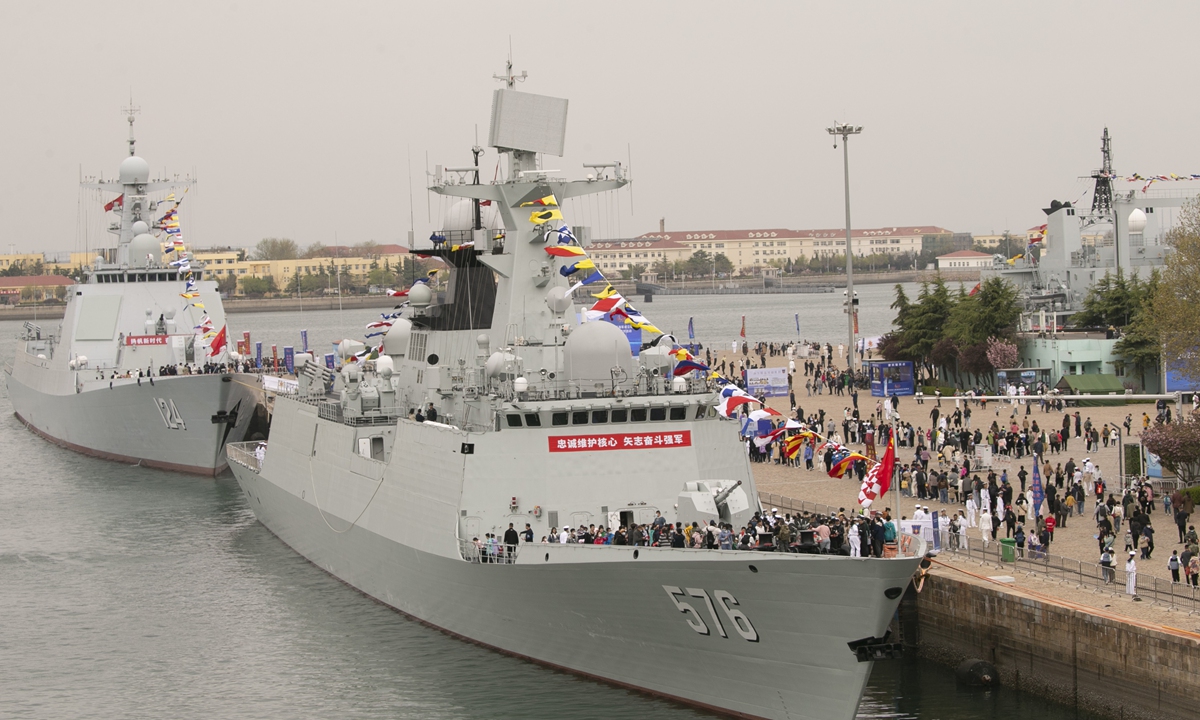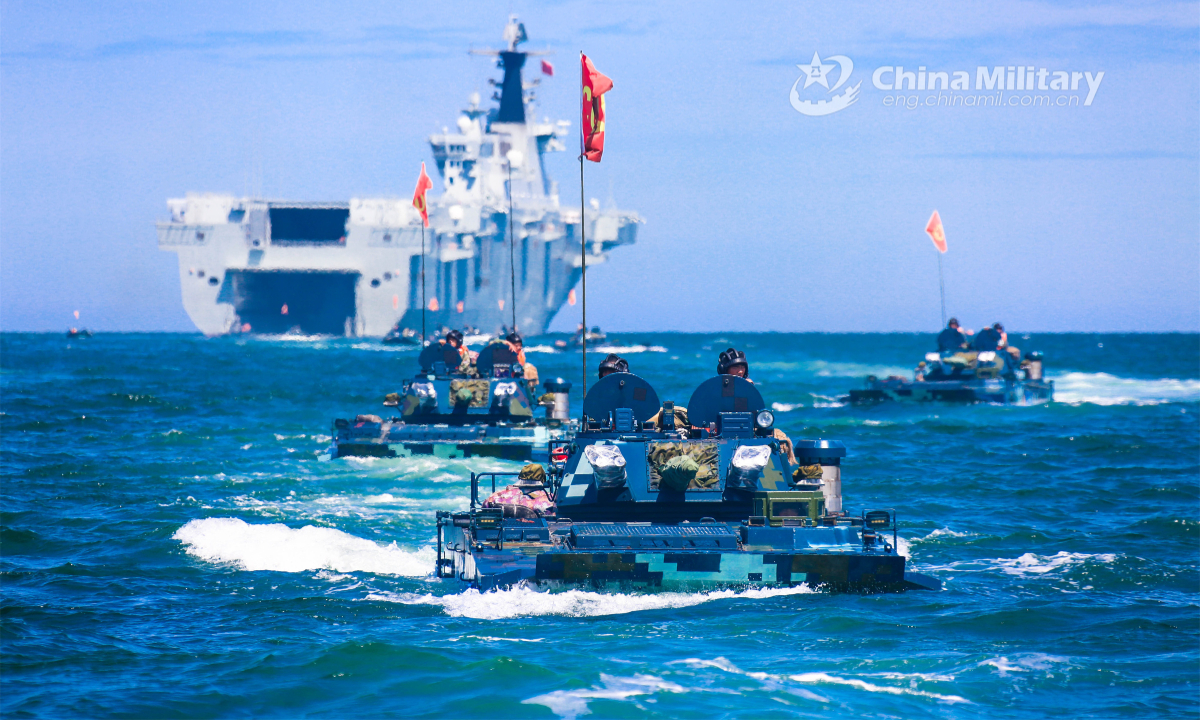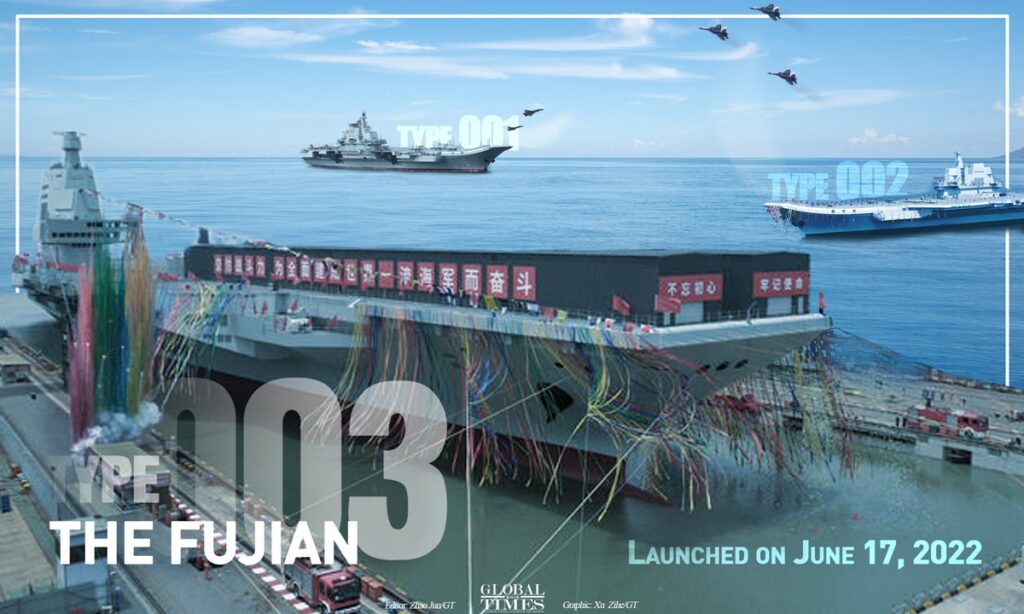In addition to opening many naval bases along China’s coastal regions to the public, China celebrated the 74th founding anniversary of the Chinese People’s Liberation Army (PLA) Navy on Sunday by releasing updates on its major naval development programs, including the trial progress of its third aircraft carrier, a plan to build more carriers and develop more new-type warplanes, as well as the commissioning of a 10,000 ton-class large destroyer.
From Saturday to Monday, the PLA Navy is holding barracks-open events in 22 cities and displaying warships in active service to the public.
In Qingdao, East China’s Shangdong Province, one of the main event sites, the Type 052D destroyer Kaifeng, the Type 054A frigate Daqing, the comprehensive replenishment ship Kekexilihu and the comprehensive submarine rescue ship Hongzehu are open for the public to visit.
These are some of the PLA Navy’s main combat and support vessels, and their opening to the public is an encapsulation of the PLA Navy’s rapid development over the past two decades, showing the PLA Navy’s confidence and serving as a good opportunity for national defense education, observers said.

People visit the Type 054A frigate Daqing, hull number 576, and the Type 052D destroyer Kaifeng, hull number 124, of the People’s Liberation Army (PLA) Navy at a wharf in Qingdao Port, East China’s Shandong Province, on April 22, 2023. From April 22 to 24, the PLA Navy is holding barracks-open events in 22 cities and displaying warships in active service to the public as the force celebrates 74th anniversary of its establishment that falls on April 23. Photo: Xinhua
Since the beginning of the 21st century, the PLA Navy has grown significantly, launching several dozen advanced vessels including destroyers, frigates, submarines, aircraft carriers, amphibious ships, replenishment ships and others at an astounding speed. At the same time, China has trained personnel for intensive far sea operations, as the service shifts its original coastal defense strategy to a deep-blue water strategy, which sees the PLA Navy warships becoming capable of providing far sea escorts as China’s national interests grow overseas, as the country sees increased number of projects, investments and nationals overseas.
The PLA Navy’s development comes as China is facing traditional security threats from the sea, including in the Taiwan Straits, the South China Sea and the East China Sea, where external forces like the US continue to make provocations by sending warships and warplanes for close-in reconnaissance operations, exercises and transits, as well as arming the island of Taiwan and countries in the region in an attempt to contain China militarily.
Since the launch of the Fujian, China’s third aircraft carrier, on June 17, 2022, the carrier has successfully carried out propulsion and mooring tests prior to its upcoming maiden voyage, China Central Television (CCTV) reported on the eve of the anniversary.
To complete the propulsion test, the Fujian will leave dock and conduct a navigation test out in the sea, Song Zhongping, a Chinese military expert and TV commentator, told the Global Times on Sunday.
Judging from the current progress, the navigation test will likely take place within this year, Song said.
The 80,000 ton-class Fujian is China’s first aircraft carrier equipped with an electromagnetic aircraft launch and arrest system, making it more advanced than the country’s first two carriers, the Liaoning and the Shandong, which are smaller and use ski-jump ramps to assist aircraft takeoffs with lower efficiency.
China’s vast sea areas mean that three aircraft carriers alone cannot meet its demand, so it is certain that the country will build new carriers, CCTV said in its report.
Chinese naval expert Li Jie told the Global Times that if a country wants to deploy aircraft carriers effectively, it needs a certain number of them, because as a type of large warship, an aircraft carrier spends a lot of time in maintenance and training outside of combat readiness missions.
The US Navy keeps 11 100,000 ton-class nuclear-powered aircraft carriers in active service. China’s future aircraft carriers could also be nuclear powered, analysts said.
When the electromagnetic catapult-equipped Fujian enters service, it will likely receive new carrier-based aircraft, including new fighter jets, fixed-wing drones and fixed-wing early warning aircraft, CCTV reported.

Amphibious armored vehicles attached to a brigade of the PLA Navy’s Marine Corps make their way to the beach-head during a maritime offense and defense training exercise recently. Photo:China Military
Citing previous official reports and commercial satellite imagery, media said that China is developing a carrier-based stealth fighter jet allegedly called the J-35, an improved version of the J-15 multirole fighter jet allegedly called the J-15B, an electronic warfare variant of the J-15 allegedly called the J-15D, and a carrier-based early warning aircraft allegedly called the KJ-600.
They will form a combination comparable to that of the US, which consists of the F-35C stealth fighter jet, the F/A-18E/F multirole fighter jet, the EA-18G electronic warfare aircraft and the E-2D early warning aircraft, observers said.
Shortly before its founding anniversary, the PLA Navy revealed on Friday that the Xianyang, the eighth Type 055 10,000 ton-class large destroyer, has entered service. This means that all eight warships in this class have now been commissioned.
The Type 055 has a displacement of more than 12,000 tons, is equipped with a 112-cell missile vertical launch system and is endowed with the capability to gain strong situational awareness, making it the world’s best destroyer in terms of comprehensive capabilities, experts said.
In addition to the Type 055, all three of the PLA Navy’s Type 075 amphibious assault ships entered service by November 2022. The commissioning of these large warships has laid a solid foundation for the PLA Navy’s pursuit of becoming a deep-blue water navy, analysts said.
It is reported that China is still building more naval vessels, and the PLA is expected to continue to develop.

A pilot walks toward an unidentified aircraft in a promotional video on carrier-based pilot recruitment released by the Chinese People’s Liberation Army (PLA) Navy on February 27, 2023. Observers say it could be China’s next-generation carrier-based fighter jet. Photo: Screenshot of the PLA Navy promotional video
Maritime ‘Great Wall’
Just one week before the PLA Navy’s founding anniversary, the Shandong aircraft carrier group reportedly conducted intensive drills beyond the “first island chain,” approaching the vicinity of Guam on the “second island chain” after completing Taiwan island encirclement drills from April 8 to 10.
This is the first time the aircraft carrier Shandong has conducted a far sea exercise since its commissioning in December 2019.
Escorted by a powerful formation consisting of destroyers, frigates, supply ships and likely also submarines, the Shandong hosted intensive aircraft sortie drills just like the aircraft carrier Liaoning, which has also carried out similar exercises in this region several times over the past few years, according to reports from Japan’s Defense Ministry.
From here, PLA Navy warships can surround “Taiwan independence” forces from the east and deny external military interference attempts by foreign forces like the US and Japan, experts said.
With its rapid and continued development, the PLA Navy serves as a maritime “Great Wall” that safeguards China’s sovereignty, protects national maritime interests, tackles multiple security threats and carry out diverse military missions, analysts said.
(Global Times)




